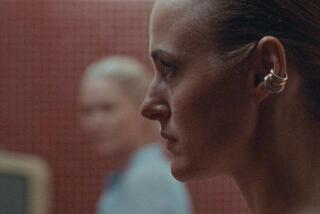Essay: ‘Amour’ is a horror film for the ages
- Share via
There is no cabin in the woods or scary house at the end of the street in “Amour.” There is no ax-wielding Jack Nicholson running around. Yet filmmaker Michael Haneke’s examination of the final days of a long life — and a long love — may be the quintessential horror film for our times. It has a remarkable ability to scare the living daylights out of audiences of any age.
With five Oscar nominations — including best picture in the overall race and best foreign language film as Austria’s entry — “Amour” is one of the finest relationship dramas ever made. It’s a beautifully crafted film about the ties that bind a long-married couple.
It’s also an extraordinary performance piece for Jean-Louis Trintignant as Georges and lead actress nominee Emmanuelle Riva as Anne, a woman beset by the relentless and ruthless physical decline of old age — blocked arteries, two strokes, confusion that might be dementia, partial paralysis, incontinence, pain, and more pain. Riva makes the journey frighteningly real.
OSCARS 2013: Complete list | Snubs & surprises | Reactions | Play-at-Home ballot | Oscars 2013 trivia | Oscar Watch | Timeline| Full coverage
That fright factor — as beautifully crafted as Anne and Georges’ relationship — is what most intrigues in “Amour.”
Death is the villain, the one adversary that can’t be cheated or outmaneuvered. In the end, it always comes, and as “Amour” captures in such detail, rarely is the retreat into that good night gentle. The way in which Haneke illustrates and illuminates the final battle is truly the stuff of nightmares.
The middle-aged will see their parents, or a glimpse of what their own future may hold. For the old, it is a searing cut at the everyday aches and ills that are slowly, or rapidly, overtaking them, and the loved ones who’ve already lost the war. For the young, who swing between anxiety and denial that aging will happen to them, Haneke puts fear vividly in every liver-spotted frame.
This is far from the first time the director — nominated for directing and original screenplay Oscars for “Amour” — has trafficked in uncomfortable truths. Indeed there is always a sense of threat in his work. “The White Ribbon” (2009), which earned two Oscar nominations, was an eloquent dissertation on children’s chilling capacity for evil. But that seems a mere warmup for his treatise on aging and end-of-life issues. That the subject itself is close to taboo in this country has meant a box-office struggle for the film, with few eager to see it despite the awards raining down.
And yet, by using many standard horror-movie tropes, Haneke has given the film a heightened energy and mystery that serve as well-timed relief from the tension of Anne’s decline. Whether by intent, design or intuition, the director fills the film with the unexplained — sounds and silence, shadows and darkness, dreams and reality, locked doors and open windows — all the stuff that can play tricks on the mind. Haneke has created a classic cerebral scare, a good companion for the emotional one at the film’s center.
In “Amour,” the isolating device, seen in so many horror movies, is their Paris apartment, which unlike its occupants is aging nicely. Virtually no one ventures inside except for Anne and Georges. Even Eva (Isabelle Huppert), their daughter, seems an unwelcome visitor. Bound by love and life, the couple are almost like a single entity, which makes the growing separation between the living and the dying all the more horrific.
Though death is the only possible outcome, Haneke has stacked the final struggle with so many torturous twists it is terrifying. Indeed it is the endgame that Anne fears most, the hair-raising specter of slowing losing all the pieces of life that used to make sense of her world. Can there be anything worse?
Haneke suggests yes: watching it happen to one you love. For Eva, the question is hospital or hospice. For Georges, there is no question, a promise has been made and home it will be. For Anne, death can’t come soon enough.
There is no more frightening scene than when Georges comes back early one day to find the windows to the courtyard flung open, Anne crumpled underneath, her wheelchair at a distance.
“I wasn’t quick enough,” she says. It is an apology. Anne wants to spare herself and Georges the indignities of her decline; Haneke has no intention of sparing us.
Sometimes the nightmares surface in dreams, and Haneke proves masterful at blurring the line between the imagined and the real.
Perhaps the most emotionally illuminating is when Georges hears the doorbell in the dead of night. When no one is there, he starts down the hall. Soon he’s wading into rising water, a hand clamps over his mouth, his eyes fill with panic. He wakes screaming to the reality that he is drowning, suffocating in Anne’s declining health.
Like all really good horror movies, there are philosophical questions to be pondered. In “Amour,” it comes in on the wings of a pigeon that flies through an open window. The fluttering wild creature, its fate in Georges’ hands, and those windows Haneke keeps leaving open, become a metaphor for life and what constitutes freedom. Ultimately, Haneke raises more questions than he answers — perhaps that is his scariest move of all.
PHOTOS AND MORE
VIDEO: The making of ‘Argo,’ ‘Les Miz’ and more
ENVELOPE: The latest awards buzz
PHOTOS: NC-17 movies: Ratings explained
More to Read
From the Oscars to the Emmys.
Get the Envelope newsletter for exclusive awards season coverage, behind-the-scenes stories from the Envelope podcast and columnist Glenn Whipp’s must-read analysis.
You may occasionally receive promotional content from the Los Angeles Times.











